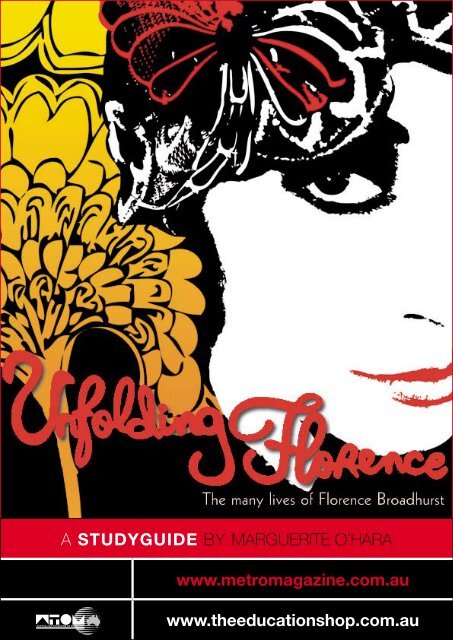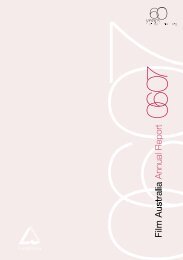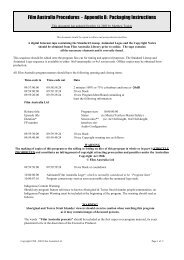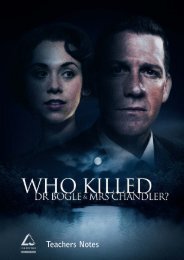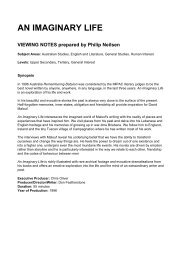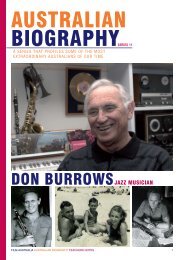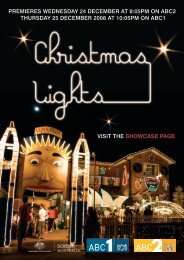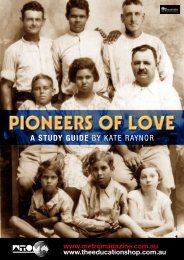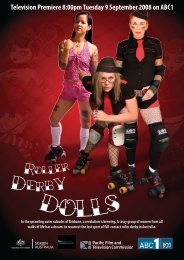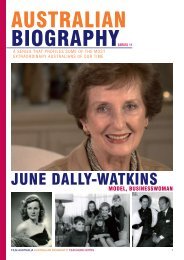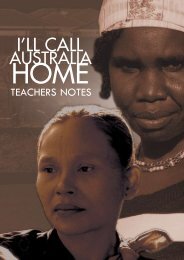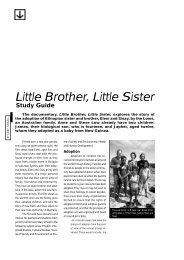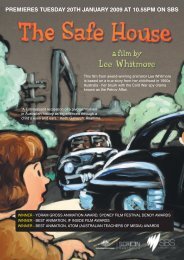Unfolding Florence Teachers Notes
Unfolding Florence Teachers Notes
Unfolding Florence Teachers Notes
Create successful ePaper yourself
Turn your PDF publications into a flip-book with our unique Google optimized e-Paper software.
A STUDYGUIDE by Marguerite O’Hara<br />
www.metromagazine.com.au<br />
www.theeducationshop.com.au
Synopsis ><br />
‘Almost everyone thinks they know who I was and, of course, everyone thinks they know who killed<br />
me …’.<br />
But what acclaimed director Gillian Armstrong reveals in this spirited and highly original documentary<br />
is that almost nothing about <strong>Florence</strong> Broadhurst was as it seemed.<br />
When she was found murdered in her studio in 1977, few guessed her age, let alone her origins. For<br />
invention and reinvention were the keys to this flamboyant design pioneer, whose signature use of<br />
colour and pattern has captured the world’s imagination.<br />
Born into a farming family in outback Australia in 1899, by her mid-twenties she was a singer and<br />
dancer in Shanghai, setting up her own performing arts academy. By the 1930s, she ran a fashion<br />
boutique in London’s Mayfair under the name Madame Pellier, before sweeping into Sydney society<br />
with a whole new persona – as a painter and charity queen, with a husband (her second) and a son.<br />
But it was in her last incarnation that she really made her mark, shaking up conservative Australia with<br />
her bold, exotic wallpapers.<br />
Now, more than 100 years after her birth, her work has been rediscovered by the world’s leading fashion,<br />
interior and homeware designers and her prints are in huge demand internationally.<br />
This is a celebration of the many lives of one larger-than-life woman – gutsy, head-strong, imposing,<br />
complicated, and almost impossibly glamorous. Told in a style that’s vibrant and unconventional, with<br />
more than a touch of humour and irreverence. A lot like <strong>Florence</strong> herself.<br />
‘I’d always been told that I was born before my time. Oh, surely to God, the times can just catch up.’<br />
The interview set from the documentary <strong>Unfolding</strong> <strong>Florence</strong>, the story of flamboyant Australian design pioneer <strong>Florence</strong> Broadhurst. Photograph by<br />
Anne Zahalka © Film Australia<br />
SCREEN EDUCATION
The film and the filmmakers > <strong>Unfolding</strong> <strong>Florence</strong> – The Many Lives of <strong>Florence</strong> Broadhurst<br />
premiered at the Sundance Film Festival in America in January 2006 at the World Cinema Documentary Competition.<br />
Its Australian premiere was at the Sydney Film Festival in June 2006. The film’s director, Gillian Armstrong, is one of<br />
Australia’s most acclaimed directors, having to her credit many feature films including Oscar and Lucinda, Little Women,<br />
High Tide, Starstruck and My Brilliant Career. She has also made a number of documentaries, including four films tracking<br />
the lives of three women from girlhood to motherhood, amongst them Not Fourteen Again. Her films have won numerous<br />
national and international awards. The film’s writer, Katherine Thomson, has written for both theatre and television. Her<br />
television credits include All Saints, McLeod’s Daughters, Snowy, GP and the award winning mini-series Answered By Fire,<br />
which she co-wrote. Her work has also won a number of industry awards.<br />
Curriculum Links > <strong>Unfolding</strong> <strong>Florence</strong> – The Many Lives of <strong>Florence</strong> Broadhurst will have interest and<br />
relevance for teachers and students at middle to upper secondary and tertiary levels. Curriculum links include English,<br />
Media Studies, Filmmaking, Visual and Creative Arts and Design and SOSE/HSIE at school level. The film is also<br />
relevant to Textiles and Design. Media Studies students should find the film of particular interest for the range of<br />
techniques used by the director to ‘unfold’ a life.<br />
Clockwise top left: Gillian Armstrong; Katherine Thomson, the writer of <strong>Unfolding</strong> <strong>Florence</strong>, on set. Photograph by Anne Zahalka © Film Australia;<br />
Director Gillian Armstrong (left) on location with actor Judi Farr as <strong>Florence</strong> Broadhurst in <strong>Unfolding</strong> <strong>Florence</strong>. Photograph by Anne Zahalka © Film<br />
Australia<br />
SCREEN EDUCATION
Introducing <strong>Unfolding</strong> <strong>Florence</strong> > This picture of a colourful but elusive<br />
figure is constructed in such a way that while aspects of <strong>Florence</strong> Broadhurst’s life and times<br />
are brought into focus, many aspects of her remain hidden.<br />
For such an energetic self-promoter, much of her life remains<br />
a mystery. Gillian Armstrong uses a number of devices to<br />
quite literally ‘animate’ Broadhurst’s life. Despite having lived<br />
until 1977 and been well-known in Sydney society, there was<br />
not a lot of archival film available to Gillian Armstrong to use<br />
in this documentary, and we build our sense of her life from<br />
the often contradictory accounts presented of her, from both<br />
<strong>Florence</strong> herself and a number of people who worked with<br />
her or came into contact with her during her seventy-eight<br />
years. In the one brief television interview shown of her from<br />
the 1970s, where she talks about her business, she seems<br />
to be wearing one of her masks. It is for the filmmaker and<br />
viewer to ‘unfold <strong>Florence</strong>’.<br />
‘Who are all these people talking about<br />
me?’<br />
There are many people in this film who add little pieces to<br />
the puzzle that is <strong>Florence</strong>. Parts of their interviews are cut<br />
into the film to construct the narrative. While this is not a<br />
complete list, these people can be grouped into:<br />
Family and people from <strong>Florence</strong>’s early life<br />
Robert Lloyd-Lewis (son), Phyllis Nicholson (niece), Mary<br />
Shield, Les Jensen and Ted Bettiens from Mt Perry in<br />
Queensland.<br />
Sydney society connections, acquaintances, friends,<br />
academics and designers<br />
Babette Hayes, Maggie Tabberer, Leslie Walford, Ivan<br />
Methot, Judit Korner, Marno Parsons, Diana Richardson,<br />
June Gollan, David Lennie, Peter Travis, Professor Ross<br />
Steele, Dr Juliette Peers, Akira Isigowa<br />
Broadhurst staff<br />
David Bond, Kate Dagher, Leonie Naylor, Phyllis Wright,<br />
Paulene Graham, Sally Fitzpatrick, Nerissa Greenwood,<br />
Karen Cope-Williams, Peter Leis<br />
Clockwise Top Left: Judit Korner is interviewed in <strong>Unfolding</strong> <strong>Florence</strong>. Photograph by Anne Zahalka © Film Australia; Maggie Tabberer is interviewed in<br />
<strong>Unfolding</strong> <strong>Florence</strong>. Photograph by Anne Zahalka © Film Australia; Animated photographs of <strong>Florence</strong> Broadhurst. All graphics in the documentary are<br />
by SV2 Animation Studio. © Film Australia, the New South Wales Film and Television Office and SBS Independent.<br />
SCREEN EDUCATION
Using <strong>Unfolding</strong> <strong>Florence</strong> in the classroom > Given that this film<br />
covers more than seventy years and includes a great deal of information as it unfolds <strong>Florence</strong>’s<br />
many lives and times, teachers may choose to select one of the four sets of questions<br />
that follow, depending on the students’ level and particular interests and/or area of study.<br />
For SOSE (HSIE) students, the picture presented of a<br />
woman’s life spanning the first seventy-eight years of the<br />
20th century in Australia and elsewhere, Living in the Seventies,<br />
the first set of questions, may be the focus. Media<br />
Studies teachers and students may find the second set of<br />
questions, <strong>Unfolding</strong> <strong>Florence</strong>, most interesting, as they<br />
deal with the structure and style of the film as an example<br />
of documentary biography. Students of Art and Design<br />
may choose to look more closely at the second part of the<br />
film, when <strong>Florence</strong> is developing her wallpaper business<br />
and respond to the Colour and Design questions. English<br />
students may prefer to look at how Gillian Armstrong creates<br />
this complex and not always complimentary picture of<br />
a woman who chose to live in her own way at a time when<br />
this was not always easy or admired. The I am <strong>Florence</strong><br />
questions will best suit this approach.<br />
Both the list of characters and the sets of quotes (following<br />
these activities), from both <strong>Florence</strong> and the people interviewed,<br />
are there to assist students in appreciating the film<br />
and responding to the questions.<br />
Note: The Office of Film and Literature Classification has<br />
classified the film PG (parental guidance recommended),<br />
with the consumer advice: infrequent mild coarse language,<br />
mild themes.<br />
From Left: Designer Akira Isogawa in front of an original <strong>Florence</strong> Broadhurst design. Photograph by Anne Zahalka © Film Australia; Felicity Price plays<br />
the young <strong>Florence</strong> Broadhurst in <strong>Unfolding</strong> <strong>Florence</strong>. Photograph by Anne Zahalka © Film Australia<br />
SCREEN EDUCATION
Student Activities<br />
1. Living in the Seventies (and before)<br />
a. How is the personality of <strong>Florence</strong> set up in the opening<br />
sequence of the film, in the dramatizing of the Black<br />
and White Ball in Sydney in the 1950s?<br />
b. Where and when was <strong>Florence</strong> Broadhurst born?<br />
c. What do we learn about her family in the film?<br />
d. Which aspects of her childhood does Gillian Armstrong<br />
include that indicate something of <strong>Florence</strong>’s determination<br />
to be ‘somebody’?<br />
e. Where did she travel to in the early 1920s? How difficult<br />
would this travelling have been compared to today?<br />
f. What did she do in Shanghai and what did she call<br />
herself?<br />
g. When did <strong>Florence</strong> travel to England and what work<br />
did she do there? What sort of troubles did she get into<br />
in London in connection with her business activities?<br />
What did she call herself?<br />
h. What expectations did <strong>Florence</strong> have of married life?<br />
Were they realized?<br />
i. When <strong>Florence</strong> came back to Australia in 1949, how<br />
had her life and family situation changed? Where did<br />
she live and how did she go about setting herself up in<br />
Sydney society?<br />
j. Describe some of the projects she embarked on. How<br />
successful and satisfying were they?<br />
k. In 1964, aged sixty-four, <strong>Florence</strong> began developing a<br />
new business. What was this and how did she build the<br />
business?<br />
l. Ideas about class, celebrity and ‘society’ figure largely<br />
in many of the comments made by both men and<br />
women contemporaries of <strong>Florence</strong> in this film e.g. ‘I<br />
think she could stand at the back of a room and put a<br />
price tag and a label on everybody in it’. Have these<br />
ideas about class and social status changed or do<br />
people achieve ‘celebrity’ in Australian society today in<br />
the same way <strong>Florence</strong> did?<br />
m. In what ways was <strong>Florence</strong> both ‘of her times’ and ‘a bit<br />
bohemian’?<br />
n. What happened to <strong>Florence</strong> on 15 October 1977? What<br />
sort of speculation is there about this event by people<br />
interviewed in the film?<br />
Above: Original <strong>Florence</strong> Broadhurst wallpapers from the documentary <strong>Unfolding</strong> <strong>Florence</strong>. Photograph by Anne Zahalka © Film Australia<br />
SCREEN EDUCATION
2. <strong>Unfolding</strong> <strong>Florence</strong> but not wrapping her up<br />
‘No matter what, you have to have a structure for documentary.<br />
To tell a tale you need to have a form.’<br />
<br />
Gillian Armstrong, Director.<br />
a. What would be some of the difficulties and challenges<br />
in making a film about a woman like <strong>Florence</strong> Broadhurst?<br />
b. How much archival and contemporary footage of<br />
Broadhurst, both still and moving images, seemed to be<br />
available to the filmmakers?<br />
c. How effective is the device of using three different actors<br />
to play <strong>Florence</strong> at different times in her life?<br />
d. At various points in this film, Gillian Armstrong uses animation<br />
to enliven static photographic images. Describe<br />
some of these animations and explain how successful<br />
you found this technique.<br />
e. Many people were interviewed in the making of this film.<br />
How does Armstrong avoid the ‘talking heads’ style of<br />
interview that can flatten the viewer’s response to a film<br />
and detract from its visual qualities?<br />
f. To what extent is this film a traditional biographical<br />
documentary?<br />
g. Make a list of the different methods used by Armstrong<br />
in reconstructing <strong>Florence</strong>’s life, e.g. interviews with<br />
friends, colleagues and family; use of contemporary<br />
photographs.<br />
h. Biography, whether on film or written, is always selective<br />
and can never hope to offer a complete picture of a<br />
person. Does the film show us much about <strong>Florence</strong>’s<br />
domestic and personal life?<br />
i. Apart from the director and writer, many people are<br />
involved in the making of a film, as you would know<br />
from watching credits roll by at the end of a film or from<br />
the many ‘thank you’s at awards ceremonies. Choose<br />
one of these key people in the making of the film – editor,<br />
composer, costume designer, production designer,<br />
actors playing <strong>Florence</strong> – and describe how successful<br />
and important their part in the success of <strong>Unfolding</strong><br />
<strong>Florence</strong> is.<br />
j. How satisfying, apart of course from the ‘unsolved<br />
murder’, did you find the ending of this film? Propose<br />
an alternative ending. Think carefully about how a different<br />
ending might change the emphases and mood of a<br />
portrait of <strong>Florence</strong> Broadhurst.<br />
3. Colour and Design<br />
a. How does Gillian Armstrong ensure that <strong>Florence</strong>’s<br />
designs are prominent in the film?<br />
b. What age was <strong>Florence</strong> when she set up her wallpaper<br />
design business?<br />
c. What was there in <strong>Florence</strong>’s past that indicated she<br />
had both an interest and a talent for artistic activities?<br />
d. Look at some of the <strong>Florence</strong> Broadhurst designs<br />
on the Signature Prints website (see references) and<br />
describe the characteristics and style of several of her<br />
designs.<br />
e. How do some of the patterns suggest that <strong>Florence</strong>’s<br />
early travels in Asia have influenced the designs?<br />
f. How do members of her staff – designers, colourists,<br />
printers, personal assistants – remember <strong>Florence</strong> as<br />
their boss? Describe the working atmosphere in the<br />
factory. What would be the good and bad aspects of<br />
working with someone like <strong>Florence</strong>? (The quotations<br />
following these questions will help with this.)<br />
g. What was one of the important design innovations to<br />
extending the use of wallpaper initiated and developed<br />
by <strong>Florence</strong> and her staff?<br />
h. Why did the interior designer, Leslie Walford, prominently<br />
featured in the film, like using Broadhurst wallpapers?<br />
i. What happened in the 1980s that meant the Broadhurst<br />
wallpapers were less sought after by people?<br />
j. ‘When you look through the library, you see the level of<br />
excellence … and it’s opulent … and visually gorgeous.’<br />
<br />
(David Lennie)<br />
How important have David and Helen Lennie of Signa-<br />
Clockwise Top Left: Felicity Price plays a model on a <strong>Florence</strong> Broadhurst photo shoot in <strong>Unfolding</strong> <strong>Florence</strong>. Photograph by Anne Zahalka © Film<br />
Australia; Judi Farr plays <strong>Florence</strong> Broadhurst in <strong>Unfolding</strong> <strong>Florence</strong> – The Many Lives of <strong>Florence</strong> Broadhurst. Photograph by Anne Zahalka © Film<br />
Australia<br />
SCREEN EDUCATION
Positive/attractive qualities Negative/unattractive qualities Positive and negative<br />
e.g. Skilled networker<br />
Self promoter<br />
ture Prints been in ensuring that <strong>Florence</strong> Broadhurst’s<br />
designs remain cared for, archived and available? How<br />
have they done this?<br />
k. Where does the film show her patterns and papers are<br />
now being used?<br />
l. Account for the renewed interest in these designs in the<br />
world of fashion and interiors. You may like to find retail<br />
outlets now selling bags and accessories using <strong>Florence</strong><br />
Broadhurst patterns and designs.<br />
4. ‘I am <strong>Florence</strong> … or Bobby or Madame<br />
Pellier or …?<br />
a. What sort of child was <strong>Florence</strong> Broadhurst?<br />
b. How did her early experiences in Queensland shape her<br />
outlook and attitude to life and opportunities?<br />
c. Why did she want to leave Queensland as a young<br />
woman?<br />
d. Describe the way <strong>Florence</strong> Broadhurst is shown on the<br />
morning of 17 October 1977 as she walks to her business<br />
premises in Paddington.<br />
e. Why do you think <strong>Florence</strong> liked people to think of her<br />
as being English?<br />
f. Was she, as some people assert, a snob; if you believe<br />
she was, how is her snobbishness shown in the film?<br />
g. <strong>Florence</strong> Broadhurst has been described as a ‘flamboyant<br />
design pioneer’. Is this complimentary? In the chart<br />
above make a list of her qualities in each column, and<br />
then tick those which could be considered as both positive<br />
and negative. Sometimes words can have either<br />
positive or negative connotations, e.g. determined or<br />
pig-headed.<br />
h. The writer of the film, Katherine Thomson, says that<br />
<strong>Florence</strong><br />
… had many lives: as a performer, in fashion, in art and<br />
as a fundraiser and socialite. All these lives fed into the<br />
very successful wallpaper business she set up when she<br />
was in her sixties.<br />
Sixty is the age at which many people retire. Do you<br />
know of people who have begun new careers at this<br />
age and been successful?<br />
i. <strong>Florence</strong>’s son Robert was born quite late in her life.<br />
What evidence is there in the film about what sort of<br />
mother she was? Does the film provide clues to why<br />
she was like she was?<br />
j. What are some of the insights Robert Lloyd-Lewis has<br />
into his mother today?<br />
k. Many of the people who worked with <strong>Florence</strong> Broadhurst<br />
remember her with warmth and affection. Describe<br />
the sort of employer you think she would have<br />
been and indicate whether you could work productively<br />
with someone with such a ‘big personality’.<br />
l. How would you respond to Leslie Walford’s suggestion<br />
that<br />
… the fault is like a worm in the apple, it’s there from the<br />
beginning … and is going to destroy everything in the<br />
end … the bad end … is what she had.<br />
What do you think he is implying?<br />
Above: <strong>Florence</strong> Broadhurst, Shanghai, 1926-27. Collection: Powerhouse Museum, Sydney, Australia.<br />
SCREEN EDUCATION
The things people say > Some of the phrases and sayings attributed to <strong>Florence</strong><br />
suggest she had a strong belief in her capacity to re-invent herself and always keep moving forward.<br />
What else do the following statements suggest about her<br />
personality?<br />
• ‘The trick is always to stand out from the crowd and<br />
never let anyone see how desperate you are.’<br />
• ‘Always make setbacks sound like opportunities.’<br />
• ‘Visualize with faith and you will become the happy,<br />
winning, magnificent personality you would like to be.’<br />
• ‘One must will oneself to be undefeated by circumstances.’<br />
• ‘Second-hand trucks is not quite the fabulous life I had<br />
in mind.’<br />
• ‘Dumped at sixty for a dame six months younger than<br />
one’s own son … knocked for six for about six minutes.’<br />
• ‘Great success starts when you least expect it.’<br />
Members of her staff suggest that despite her apparently<br />
successful and busy life, she was really quite lonely. Here<br />
are some of the things said about her by various people<br />
who knew her and worked with her. What clues do they<br />
provide in the quest to ‘unfold <strong>Florence</strong>’?<br />
• ‘She was sort of like a superstar.’<br />
• ‘She never, ever, ever, smiled.’<br />
• ‘I always thought she was English.’<br />
• ‘She was larger than life.’<br />
• ‘She was never “a lovely little woman”, as someone<br />
said at her funeral.’<br />
• ‘I had heard that she had sung with Dame Nellie Melba.’<br />
• ‘She really wasn’t a designer at all, but she was a great<br />
promoter.’<br />
• ‘In the history of design in Australia she’s a very significant<br />
figure.’<br />
• ‘She was … the little black sheep of the family.’<br />
• ‘She was one of the most driven women I’ve ever<br />
known.’<br />
• ‘Her mother and sister were paying off her debts for<br />
many years after she left.’<br />
• ‘She never came to see me at boarding school. Neither<br />
did my father.’<br />
• ‘She always tried to be something she wasn’t.’<br />
• ‘She spoke on the meaning of Dunkirk … and it was<br />
absolutely compelling.’<br />
• ‘She was the worst of bosses and the best.’<br />
• ‘She was a very hard lady but very fair.’<br />
• ‘Motherhood was not her forte.’<br />
• ‘She is one in a million.’<br />
Above: Producer Sue Clothier appears as an extra in <strong>Unfolding</strong> <strong>Florence</strong> – The Many Lives of <strong>Florence</strong> Broadhurst. Photograph by Anne Zahalka ©<br />
Film Australia<br />
SCREEN EDUCATION
<strong>Unfolding</strong> <strong>Florence</strong> further<br />
1. At several points in this film, both the filmmaker and<br />
people interviewed speculate on how <strong>Florence</strong> Broadhurst<br />
might have responded to things that were said<br />
about her and that have happened since her murder<br />
in 1977. For instance, Armstrong has Broadhurst<br />
expressing displeasure about her age being given in<br />
the newspaper account of her death and later someone<br />
speculates that ‘she would have been flattered with the<br />
revival [of her wallpapers]. But at the same time she<br />
would have thought it was her due’.<br />
Write an extended review of this film in the voice of <strong>Florence</strong><br />
Broadhurst.<br />
2. Write your own review of the film that describes and<br />
comments on how the use of creative and original<br />
approaches to biography creates a picture of a complex<br />
woman.<br />
3. What this film became … is a tribute to a life lived<br />
authentically, a life driven by creative impulses, lived<br />
with self-knowledge, pushed along by a sense of what it<br />
might become. <strong>Florence</strong> was always becoming something<br />
and filling herself out.<br />
(Katherine Thomson, writer of the film)<br />
‘She was a difficult person to work for. She was a taskmaster.<br />
And she expected perfection from her staff.’<br />
(Karen Cope-Williams, Personal Assistant to <strong>Florence</strong><br />
Broadhurst)<br />
Conduct a class forum about how you see <strong>Florence</strong>,<br />
using these two statements as starting points.<br />
4. Construct a series of interview questions for <strong>Florence</strong><br />
Broadhurst for a television program you are making<br />
about her life and work in 1976. You could role-play this<br />
interview with a partner.<br />
5. By investigating the Signature Prints website, develop a<br />
number of designs for clothing and accessories based<br />
on <strong>Florence</strong> Broadhurst designs.<br />
Above: Animated photographs from the documentary: top right is of the Royal Family; others of <strong>Florence</strong> Broadhurst. All graphics in the documentary<br />
are by SV2 Animation Studio. © Film Australia, the New South Wales Film and Television Office and SBS Independent.<br />
SCREEN EDUCATION<br />
10
References and Further<br />
Resources<br />
Books<br />
Siobhan O’Brien, A Life by Design:<br />
The Art and Lives of <strong>Florence</strong><br />
Broadhurst, Allen & Unwin, 2004.<br />
This biography was not supported<br />
by either the Lennies, as owners<br />
of the wallpaper collection, or by<br />
Robert Lloyd-Lewis, Broadhurst’s<br />
son.<br />
Helen O’Neill, <strong>Florence</strong> Broadhurst:<br />
Her Secret & Extraordinary Lives,<br />
Hardie Grant, Melbourne, 2006.<br />
This is a beautifully designed book,<br />
with many illustrations of Broadhurst’s<br />
work.<br />
Web resources<br />
Signature Prints (See <strong>Florence</strong><br />
Broadhurst’s Amazing Adventure):<br />
http://www.signatureprints.com.<br />
au (Accessed 20/06/06)<br />
Feature article from the Sydney Morning<br />
Herald from 2004 about the<br />
<strong>Florence</strong> Broadhurst revival: http://<br />
www.smh.com.au/news/<br />
Cover-Story/Go-with-the-Flo/<br />
2004/11/10/1100021847779.html<br />
(Accessed 22/06/06)<br />
Abstract of an academic paper from<br />
the University of Technology<br />
Sydney, looking at the sources and<br />
influences of Broadhurst’s designs:<br />
http://www.rmit.edu.au/<br />
departments/af/intermesh/New%20Site/<br />
Refereed%20Papers.html<br />
(Accessed 22/06/06)<br />
Article from magazine Luxury Home<br />
Design about the wallpapers with<br />
illustrations of Broadhurst designs:<br />
http://completehome.com.au/<br />
?p=4847&cid=6362&pid=101725<br />
(Accessed 22/06/06)<br />
<strong>Unfolding</strong> <strong>Florence</strong> – The Many<br />
Lives of <strong>Florence</strong> Broadhurst<br />
A Film Australia/Becker Entertainment<br />
Production produced in association<br />
with the NSW Film and Television<br />
Office and SBS Independent. A film by<br />
Gillian Armstrong.<br />
Writer: Katherine Thomson<br />
Producers: Charles Hannah, Sue<br />
Clothier<br />
Director: Gillian Armstrong<br />
Executive Producer: Mark Hamlyn<br />
Duration: 82 minutes<br />
Year: 2006<br />
Marguerite O’Hara is a freelance writer<br />
from Melbourne.<br />
For further information or to order this<br />
program, contact:<br />
Film Australia Sales<br />
PO Box 46<br />
Lindfield NSW 2070<br />
Tel: (02) 9413 8634 Fax: (02) 9416 9401<br />
Email: sales@filmaust.com.au<br />
http://www.filmaust.com.au<br />
This study guide was produced by ATOM<br />
editor@atom.org.au<br />
For more information on Screen Education<br />
magazine or to download other free study guides visit<br />
www.metromagazine.com.au<br />
For hundreds of articles on Film as Text, Screen<br />
Literacy, Multiliteracy and Media Studies, visit<br />
www.theeducationshop.com.au<br />
Notice: An educational institution may make copies of all or part of this Study Guide, provided that it only<br />
makes and uses copies as reasonably required for its own educational, non-commercial, classroom purposes<br />
and does not sell or lend such copies.<br />
SCREEN EDUCATION<br />
11


